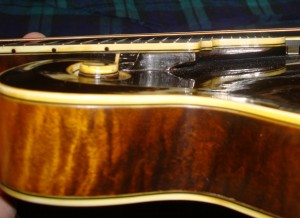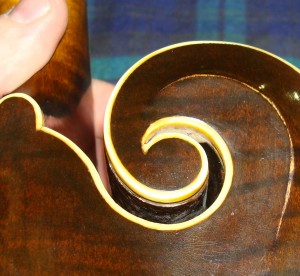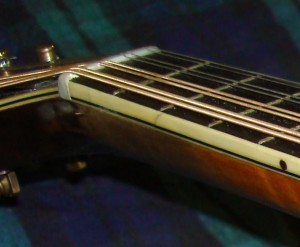I have added to my blog about my encounter with a Lloyd Loar signed F5. Below is part of the post. It is kind of windy so I didn't include it all here. I was going to include it all, but, I simply don't have the energy to format it all twice. Here is a link. Full size pics are available at the blog as well.
It has been nearly a month now and I’m still trying to catch up from my week at the IBMA in Nashville. While there, I spent some time with a Lloyd Loar signed Gibson F5 mandolin. This mandolin was signed the same day as Bill Monroe’s F5 (#73987), July 9, 1923.
This was my first opportunity to spend time with one of these highly sought after instruments. This particular instrument is serial number 73984 and may also be seen at the Mandolin Archive.
Currently, the instrument is on consignment at Elderly Instruments in Michigan; the asking price a mere $250,000. My wife indicated that I could buy it if I could live in it and she would be happy to help me get in there.
I have to start by thanking Derek at Elderly for allowing me the opportunity to hog the mandolin for my own diabolical purposes for a generous portion of the show. Before IBMA week, Elderly had sent out an email with notification that the F5 would be at their booth. So, in advance, I had verified that I could meet the instrument and spend some time playing, measuring and photographing it.
I asked for a small space where I could study the instrument. We set up a little workbench on a large cardboard box and I pulled out my flannel drop cloth, measuring tape, ruler, caliper, recorder and camera. First I took the mando in, looking at it in detail. I followed the arch of the top from the tail up through the f holes and on to the rising contour of the scroll. I must say, Orville Gibson designed a beautiful family of mandolins in the Florentine style (with scroll).
I then eyed the fretboard and followed it up to the headstock which also includes a delicate scroll. 1923 F5 Triple Side Binding I spent extra time studying the bindings. This one has a triple bound side binding. You might be surprised, but compared to the contemporary standards set by the likes of Lynn Dudenbostel, Steven Gilchrist,
Hans Brentrup and others, the fit of the bindings’ intersections and overall contour and connection of the fretboard extender support are disjointed and pretty rough respectively.

The bindings I assume have shrunk a bit. Enough to pull the miters apart slightly? Probably. On the other hand, the treatment of the binding itself is flawed. Notice in the picture to the right that the inside point where the bindings come together is seriously distorted. Along the underside of the button has some issues where the binding meets the inside side of the scroll in two places. Also, you can see the miter near the neck heel is pulled apart slightly. These flaws only illuminate the fact that although the instruments were built in a factory setting, they were constructed by humans, not computers, using materials that change in pliability and effectiveness over time. Could this be part of the reason older instruments are said to sound better than new instruments?

Surprisingly, this mandolin is in great shape. I could not identify any cracks in the finish, body, neck or headstock.

There are the occasional scratches and wear, but this is to be expected on any instrument that is played even a little. The only cosmetic flaw I could find, that was not included by the factory, was a crack in the fretboard binding at the second fret. Given the age of the mandolin, this is most likely due to shrinkage of the binding like the miters’ separation.
Orville’s right hand man in the development of the F5, was Lloyd Loar. Loar was an Illinois native born in Cropsey just East Northeast of Bloomington and grew up in Lewistown, IL only 60 miles Northwest of my current hometown of Springfield. Loar was a musician and equally if not more important a sound engineer. His additions to the F5 are the extended neck for greater playable range, tuned f holes like a violin, raised fretboard, increased break angle at the bridge, tonebars that run nearly parallel, tuned top and back plates and box, and a minimum thickness area that encompasses a greater length of the perimeter of the mandolin. Roger Siminoff has done extensive research on the life and accomplishments of Lloyd Loar and cites his tuning of the individual top and back plates, tonebars and f holes as his most prominent addition to the F5.
More to come.



